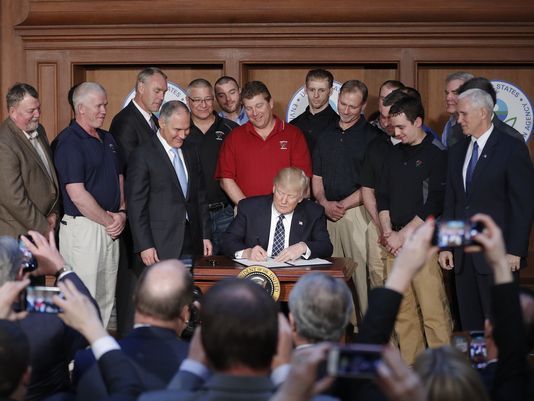
Energy companies look to tech to make oil production easier and cheaper
By
When your business is subject to the whims of boom-and-bust cycles the way the oil industry is, making money with less effort is very appealing. With that in mind, oil companies are using technology to cut costs while still turning a profit in the downturn.
“This is about reshaping the industry,” said Muqsit Ashraf, energy strategy consultant with the firm Accenture. He points out tech advances can keep workers safe.
But technology changes will also affect the workforce itself.
“The profile of the employees will change,” he said. “There would be a shift in terms of head count on the field to head count that might be sitting in remote operations centers making decisions.”
Technology is replacing energy workers. For example, oilfield services company Schlumberger has estimated one of its newer, more automated drilling rigs could cut the number of work hours needed to finish a well by more than 30 percent. But in the long term, the effect on jobs is hard to predict, according to Rice University’s Mark Agerton.
“It really depends on whether the technology is going to lower the cost of extraction and make us extract more oil and gas, and hire more people to do that, or if the technology is going to allow us to replace people with machines,” he said.
A more digitized industry also means companies will need more educated, higher-skilled workers to operate new technologies.
These advances are helping drillers in Texas make money even with low oil prices. But another boom could slow the innovation. If prices shoot back up, companies might decide to revert back to more time-tested ways of moving oil.

Blog: President Trump’s budget supports affordable energy
On Tuesday, President Trump released his 2018 budget. While the President’s annual budget usually isn’t enacted into law, it provides an important blueprint of where the administration will be focusing its efforts. If ratified, president Trump’s proposal would fulfill several key campaign promises, namely, the increasing funding for energy production, defense, and homeland security initiatives.
From an energy perspective, the President placed the highest priority on reducing energy costs and developing America’s natural resources, stating “A consistent, long-term supply of lower-cost American energy brings with it a much larger economy, more jobs, and greater security for the American people.” In addition to relaxing offshore drilling restrictions, the administration’s budget document includes a plan to open Alaska’s Arctic National Wildlife Refuge (ANWR) for oil drilling by 2022. Such a plan, if enacted, would raise $1.8 billion by 2027.
The Department of Energy faced reductions under the President’s budget, with cuts of $3.1 billion, or 18 percent. One component of that cut is the largely bipartisan federal renewable energy program known as the Advanced Research Projects Agency—Energy, or ARPA-E. A hallmark of bipartisan cooperation since it was created less than a decade ago, ARPA-E was launched under President George W. Bush as part of a broader package to encourage American innovation.
Fortunately for the President, several congressional Republicans are already on board with many his priorities, eager to roll back the preceding administration’s activism. Arizona Representative Paul Gosar commented, “Kudos to the Trump Administration for reducing bureaucratic blight within the EPA by supporting a true all-of-the-above energy strategy and providing much-needed relief to rural communities and local stakeholders.”
One idea that some Congressional Republicans are less excited about is the President’s proposal to sell off half of the Strategic Petroleum Reserve. Another revenue raiser for the federal government, the budget predicts sales would raise $16.5 billion over 10 years. However, many on the right are anxious about the national security ramifications of such a plan given the unstable geopolitical climate.
Ultimately, the President’s budget is interpreted by Congress as a strong suggestion. We will likely see Congressional appropriations bills that will reflect many of his energy priorities.

Rooftop solar has hidden risks for consumers and family businesses
By Alex Ayers
Recently rooftop solar panels have been promoted to Alabama residents as a way for energy consumers to lower their electrical bills, however there are still many risks involved that oftentimes may outweigh the benefits.
Rooftop solar panels have increased in use in recent years, 18 gigawatts of solar photovoltaics were installed between 2008 and 2014 nationwide. At this growth rate rooftop solar will play a part in supplying American consumers with electricity in the future, and Family Businesses for Affordable Energy promotes diverse energy sources because competition helps to keep energy prices affordable.
However, if growth continues before hidden costs are dealt with, it has the potential to have major impacts on the affordability of electricity for family businesses and households.
The largest growth in rooftop solar panels has come from states that mandate the price that consumers are paid to sell excess solar energy back to the grid through a policy known as net-metering. Alabama solar users currently can sell their excess power to their utility company when they are not using all of the generated power themselves at market rates instead of state mandated rates. The rates at which utilities pay consumers for the electricity vary by state, but those states that mandate retail prices shift the cost burden of maintaining the grid away from solar users to non-solar consumers. This increases the cost of electricity on low-income users and renters who cannot afford or are not allowed to install their own rooftop solar panels.
For non-solar consumers in Nevada this means an increase of $600 per year to subsidize rooftop solar users. In states where net-metering is poorly regulated it creates a regressive income transfer from those who cannot afford solar to those who can. For utilities that transfer the costs from households to commercial customers, the increased overhead cost is passed on to the consumer through increased product prices, either way consumers lose out in poorly regulated net-metering schemes.
Alabama has so far successfully stayed away from these regressive policies, buy could see pressure to change in the future.
As rooftop solar becomes more popular, it opens up the market to bad actors that try and take advantage of consumers interested in lowering their electrical bills. For consumers leasing solar panels there are often hidden costs associated with maintenance and upkeep of the panel that are not easily identifiable in the the leasing agreement.
Some companies require lessees to contract with another company to clean and maintain the panels at costs of up to $700 per year. With long-term leases of 15-20 years these requirements significantly increase the payback period of the solar panels. The leases also make moving more difficult as the leaseholder can put a lien on the entire property claiming it is necessary to protect the solar panels. Additionally, installing solar panels can increase the assessed value of the home and therefore increase the property taxes paid by the consumer.
In addition to hidden costs, some bad actors have used solar installations to scam consumers. In 2015 an Arizona judge released more than 1,000 customers from their leases from a predatory company that failed to install nearly three-quarters of the units and withheld state payments owed to customers.
In other states predatory companies can install panels claiming the cost to the homeowner will be significantly lower than buying electricity from the utility company, but when utility rates remain steady, the rates charged by the solar installer increase over time costing the homeowner more than if the panels had never been installed. As solar becomes more popular, stronger consumer protections will be needed to stop predatory companies like these.
Recent improvements in efficiency and decreasing costs of production will make rooftop solar an ever larger producer of electricity in America, however Alabama lawmakers should stay vigilant in future policymaking to ensure that the hidden costs are not shifted to non-solar users, especially low income consumers who cannot afford higher electric bills. Smart policies can protect all consumers and help make energy more affordable.
Alex Ayers is the executive director of Family Businesses for Affordable Energy (FBAE). FBAE launched the Make Solar Safe initiative for consumers and policymakers to better understand how to protect solar power customers from predatory companies, unsafe construction, and other hazards.
Read original at: http://www.al.com/opinion/index.ssf/2017/05/rooftop_solar_has_hidden_risks.html

U.S. industry seeks faster permits, simpler rules in Trump regulation reset
By Valerie Volcovici and Timothy Gardner | WASHINGTON
U.S. industry groups have told President Donald Trump’s administration that they want two main things from his promised regulatory overhaul: a speedier permit process and simpler environmental rules.
Associations representing the drilling, refining, mining, and building industries have submitted hundreds of pages of documents to the Commerce Department and Environmental Protection Agency in recent weeks, outlining regulations they want to see eliminated or modified.
The comments, many targeting the EPA, come in response to a pair of executive orders Trump signed during his first weeks in office, meant to cut the regulatory burden on companies. Trump and the Republican-controlled Congress have already moved to rescind a slew of Obama-era environmental protections, including some aimed at combating global climate change.
The EPA’s regulatory reform office alone has received remarks from more than 65,000 people and groups, many of them criticizing the regulatory rollback plan as a potential threat to public health. But business groups have embraced the plan, calling it the best chance in more than a decade to reshape the regulatory landscape and boost growth, without undermining air and water quality.
“Last time I remember this was 2001. That was the last big opportunity to make some changes,” said David Friedman, vice president of regulatory affairs for the American Fuel & Petrochemical Manufacturers industry group.
That year, then Vice President Dick Cheney chaired an energy task force that produced a National Energy Policy report, a road map to boosting domestic systems and supplies. Much has changed since: U.S. oil and gas production hit all-time highs during the administration of former President Barack Obama, helped by high crude prices and improved drilling technology.
This time around, industry groups appear focused on easing the permitting process for new facilities and installations, according to a Reuters review of the comments.
A common refrain, for example, is for Trump’s administration to reject a planned tightening of ozone rules under the U.S. Clean Air Act’s National Ambient Air Quality Standards. Several groups said this would expose them to increased permitting hurdles for operations and new facilities.
Several groups mentioned other permitting requirements under the Clean Air Act that they say are redundant. These include the New Source Performance Standards, the Maximum Achievable Control Technology rules and the National Emissions Standards for Hazardous Air Pollutants.
“We have one proposal to replace eight different regulations with one that achieves the same environmental benefit but substantially reduces the cost of compliance,” said Rosario Palmieri, vice president for regulatory policy at the National Association of Manufacturers.
The American Petroleum Institute representing oil and gas companies and the Edison Electric Institute, representing electric utilities, are seeking changes in the way companies must account for greenhouse gas emissions.
Comments from members of the public and environmental groups revealed worries that this process would undermine environmental protections. The EPA’s comment period ended on May 15.
Jeff Baker, a military veteran and energy investor from Alabama wrote: “I implore you, as defenders of our nation’s health and security, to avoid shortsighted steps that might create prosperity for a few in the short term, at the expense of the many in the long term.”
Trump’s administration requested the comments from industry as part of two similar and concurrent processes, stemming from his executive orders.
The first order, issued on Jan. 24, directed Commerce Secretary Wilbur Ross to review which U.S. regulations were burdens for domestic manufacturing. The Commerce Department solicited feedback from industry as a result of that order, with a March 31 deadline.
Ross told Reuters in an interview last week that the department was condensing the comments into a series of recommendations that could be presented to Trump as early as this month. [nL1N1IB240]
The second order was issued Feb. 24, directing all U.S. agency heads to launch a process to identify regulatory burdens. Each agency has its own timetable. The EPA, which is taking the brunt of the feedback, started its public comment period on April 11 and closed it this week.

Strength in Oil and Gas Sector Bolsters Industrial Economy, Drives GDP Growth
By Thomas J. Duesterberg, Senior Fellow
The initial report on 1st-quarter Gross Domestic Product (GDP) was weak, but showed encouraging growth in the oil and gas production sector. Capital investment, which has been historically weak since the Great Recession, bounced back to a 9.4% uptick, led by expansion in oil and gas drilling and related equipment. The Federal Reserve Boardearlier reported preliminary 1st-quarter industrial production involving drilling in the oil patch was up 159% over 2016 levels. This accounts for nearly 0.5% of the reported 0.7% GDP growth in the 1st quarter. This expansion bodes well for sustainable growth in the future, as the strength in this sector has outsized impacts on the rest of the economy.
The recent rise in crude oil prices and stability in natural gas prices are behind this new- found growth, but the animal spirits unleashed by the election of President Trump have played an equally large role. Expectations of a freer hand in production, transportation, use and exports of oil and gas also loom large in the revival. It is probably not an idle coincidence that the recent trough in mining sector jobs (which includes oil and gas production) was October 2016.
Since then, over 44,000 new jobs have been created in this sector. Exports of crude oil and refined products are now over 5 million barrels per day (b/d), and natural gas exports, boosted by low-cost production due to the shale technology revolution, have led to a trade surplus of over 2 billion cubic feet per day. Crude oil exports alone in the first two months of this year are more than three times the value of oil exports in the same period in 2016. The technology revolution continues to forge ahead and gas exports will grow as new liquified natural gas (LNG) export facilities come online in the next few years.
Growing strength in the U. S. oil and gas sector is an important factor in stimulating related industries in manufacturing, construction and transportation. The steel, pumps, engines, trucks, drilling bits, earth moving equipment, and related materials used in exploration and processing of oil and gas are largely made in the United States, and, presuming President Trumps executive orders and trade actions on steel, aluminum, transport pipelines and leasing for exploration are upheld, the benefits will be even larger.
In a study I co-authored in 2014, an econometric analysis based on a projection of maintaining a level of crude oil exports of 2 million barrels per day over a ten-year period starting in 2015 would have a strong impact on related industries. Domestic machinery production would be over 3% higher, construction and mining equipment would be 6% higher; over 200,000 construction jobs would be created at the peak of building out needed infrastructure, and overall capital spending would plateau at higher levels.
In the last six months, we have already seen the early impact of these trends in job growth and production in the oil and gas sector and in manufacturing. A related benefit is that increased production to help keep fuel prices low levels tends to boost consumption even further. It is also important to the domestic chemicals and plastics industry, which is the second largest producer and exporter in the U. S. manufacturing sector.
Oil and, more importantly, natural gas and gas liquids, are the main input into U. S. chemicals production, and prices are much lower than those in Europe and the Pacific industrial nations which must import most of their raw materials. Continued growth in the efficiency of oil and gas production, largely in shale producing regions, is allowing increased production while maintaining healthy profit margins.
These trends are likely to intensify as the new tax, regulatory and leasing policies of the new administration are implemented. New policies could stimulate even higher growth, exports and job creation. The 1st-quarter is only a preview of those benefits.

Improved technology is helping boost domestic oil production
by Adam Wilmoth
A better understanding of data and technology has transformed the U.S. oil and natural gas industry and promises to help meet the global growing demand for oil, Oklahoma executives said Thursday.
Speaking at the Oklahoma State University Energy Conference, Devon Energy Corp. CEO Dave Hager said a better understanding of geology, well control and drilling technology has boosted production and lowered costs throughout the industry.
“How can we survive at $50 oil instead of $90? The use of advanced technology is helping us do that,” Hager said.
By connecting producing wells to the internet and allowing field employees to better target problem wells — often before a problem is noticeable — the company has slowed the annual production declines on its wells.
Improved technology also has allowed the company to more precisely control horizontal drilling, ensuring the well stays in the formation and is as straight as possible.
“We’re now drilling to a 10-foot tolerance in a well that 10,000 feet long,” Hager said.
Together, the efforts have helped boost initial production rates by 300 percent from 2012 to 2016.
“The biggest challenge was to get all the historical data in a usable form,” Hager said. “Then for the new data, it’s just like any other industry. We get so much data. How do you sort through the data and make meaningful use of that data? That’s where a lot of the software we’re developing is helping.”
The improved technology has allowed companies to reopen older oil fields throughout the country and double U.S. production in less than a decade. Too much production flooded the market and led to the industry downturn, but the increased oil may be needed if global demand continues to rise.
Despite the recent U.S. production gains, new discoveries still are necessary, said Frank Patterson, executive vice president of exploration and production at Chesapeake Energy Corp.
Growing consumption
Global consumption is more than 35 billion barrels of oil annually, and more than 80 percent of the world’s proven reserves are in OPEC countries. Many of those countries have unstable governments and unrest.
At current consumption, OPEC has 34 years of reserves, and all non-OPEC nations together have less than eight years of reserves.
At the same time, spending on large-scale deepwater projects has dried up during the downturn over the past three years. Those projects typically take up to a decade to reach full production.
Increased U.S. production will help meet global demand in the short run, but it’s not enough to offset growing consumption and declining global production, Patterson said.
“We will buy time for those big projects to come on, but the question is what can we ramp up to in the United States,” Patterson said. “I’m not trying to be doom and gloom. But we have to step back and ask where we’re going and how do we get there. We have to start thinking not about tomorrow, but about 2025 and 2030.”
Patterson said companies need to continue efforts to find the next big field, even though the new oil isn’t needed today.
“I think there’s a lot left to be had, but we have to think differently,” he said. “What you see is everybody go exactly where everybody else is going. You need some people out there in the front, pacesetting right now.”
Originally posted at: http://newsok.com/article/5548890

Zinke rolls back restrictions on offshore energy research
by John Siciliano
Interior Secretary Ryan Zinke took new actions on Wednesday to reverse the Obama administration’s restrictions on mapping the nation’s offshore oil and natural gas resources.
The White House got out ahead of Zinke in announcing actions to open up the Atlantic Ocean and the outer-continental shelf to companies ready to begin deepwater surveying to understand how much oil and natural gas is actually there.
Zinke’s action was the latest step in implementing President Trump’s America First offshore energy strategy by “reversing an Obama administration action to halt scientific research in the outer-continental shelf,” said White House deputy press secretary Sarah Sanders.
Zinke later said the move would restore research about the nation’s offshore resources after a more than 30-year hiatus on conducting seismic surveys and other forms of scientific research.
“Allowing this scientific pursuit enables us to safely identify and evaluate resources that belong to the American people. This will play an important role in the president’s strategy to create jobs and reduce our dependence on foreign energy resources,” Zinke said.
Wednesday’s action by the Interior Department reverses a decision made by the Obama administration’s Bureau of Ocean Energy Management “to deny the permit applications” for companies looking to conduct seismic surveys off the Atlantic coast, the agency said.
Zinke will await a remand by the Interior Board of Land Appeals of the permit denials made by the Obama administration, which will begin the review process toward approving them. Environmental groups have been opposed to the use of seismic survey tools because they say they harm marine mammals. But the Interior Department said for nearly 20 years it has “invested over $50 million on protected species and noise-related research, including marine mammals.”
The agency added that the seismic surveys “are not expected to have significant impacts on marine mammal populations or the environment given the use of advanced technology and other safeguards that are currently required.” It said the agency employs measures and safeguards to “reduce or eliminate” harm to marine life.
The Bureau of Ocean Energy Management’s “mission is to manage the development of our nation’s offshore resources in an environmentally and economically responsible way,” said the bureau’s acting director, Walter Cruickshank. “We will continue to keep the public informed as we renew our efforts to evaluate these permits.”
The bureau estimates that offshore reserves equal nearly 90 billion barrels of recoverable oil and 327 trillion cubic feet of natural gas. In 2016, offshore drilling accounted for 72 percent of the oil and 27 percent of natural gas produced on federal lands.
The effort is part of a laundry list of reviews and regulatory repeals that Zinke has been directed to conduct under executive orders Trump signed late last month.
Zinke finished the third of a four-day visit Utah on Wednesday. The trip is meant to hear from groups in the state through a series of public listening sessions. The sessions will be used to make decisions on potentially reversing former President Barack Obama’s controversial designation of the Bears Ears national monument in Utah.
The Trump administration said Obama’s decision to name the monument was rushed and did not take the time to hear from groups in the state before making a decision that curtails the use of the land for other purposes.
Zinke’s agency will be in Arizona next week as part of an effort to save the Navajo Generating Station, the largest coal-fired power plant in the West.
The department will host four listening sessions, May 15-19, in Arizona, where members of the public and local, state and tribal officials will speak on the future of the power plant. The plant is slated to close at the end of 2019.
The power plant has proven too expensive to operate given increased competition from other power plants that use natural gas to produce electricity. The owners of the plant have been in talks with Zinke and the Navajo Nation, which leases the land the plant is on, to find a way to keep it operating. Keeping the coal plant running is part of the president’s plan to restore coal jobs.
Originally posted at: http://www.washingtonexaminer.com/zinke-rolls-back-restrictions-on-offshore-energy-research/article/2622732

Pipelines can provide a path to good-paying jobs
BY ANDY BLACK, OPINION CONTRIBUTOR – 05/10/17 02:36 PM EDT
In February, a congressional subcommittee held a hearing on challenges and opportunities to promoting energy infrastructure projects. Members made statements, witnesses gave testimony and the value of new infrastructure was debated.
In response to questioning on the value of energy infrastructure, a witness responded: “The wages and compensation packages that our members receive while working on these projects underpin not only their ability to keep a roof over their families’ heads and food on the table, but they also provide for private healthcare coverage and the ability of members to earn credits toward a defined benefit pension plan.”
The energy infrastructure projects driving these comments? Pipelines. The witness making this statement? The general president of a major labor trade union.
Both industry and labor agree that pipeline projects are a major source of good-paying jobs.
Federal review of a major crude oil pipeline found the project would directly and indirectly provide tens of thousands U.S. jobs and billions of dollars in U.S. worker payroll.
While the pipeline would support 6,800 construction jobs with $420 million in payroll, it would also lead to 4,600 manufacturing jobs with $309 million in payroll; 4,400 jobs in trade with $172 million in payroll; 2,200 jobs in finance and insurance with $131 million in payroll; 5,100 jobs in other professional services with $343 million in payroll; 2,700 jobs in health services with $141 million in payroll; and 5,700 jobs in food and accommodations with $278 million in payroll.
Good-paying jobs, not just in construction, but also in manufacturing and service sectors, are the benefit of every pipeline project.
Whenever a major pipeline project is proposed, across our northern border or anywhere within the United States, thousands of jobs with millions of dollars in worker payroll can follow.
In addition, the benefits of a pipeline project will continue long after construction is completed.
Communities along the route of a pipeline will gain property tax revenue that can fund school budgets, police and fire departments, and local government needs.
Rural communities near pipelines with small budgets will benefit the most from this new influx of revenues.
Consumers across the country will benefit from the downward pressure on gasoline and diesel prices new crude oil supplies bring.
Those same government studies analyzing project benefits also find building a pipeline would do more to protect the environment and avoid greenhouse gas emissions than any alternative, including rejecting the pipeline.
According to U.S. government statistics, over 99.9 percent of petroleum products shipped by pipeline reach their destination safely. Government review found the alternatives to not building the pipeline and forcing that crude oil onto other modes of transportation would result in 2.6 times more crude oil released and 832 times more releases per year.
Transporting crude oil by pipeline also results in fewer greenhouse gas emissions. Government environmental review of a major pipeline project found that when stacked against the alternatives, operating the pipeline would result in 42 percent less carbon dioxide equivalent per year emitted than the leading alternative mode of transportation.
These statistics are why the labor union leader responded to subcommittee questioning with, “[t]hese state-of-the-art pipelines are safer, more environmentally sound, and emit fewer greenhouse gases than any other method of transporting energy resources.”
Good-paying, family-supporting jobs, lasting benefits to communities and consumers, more environmentally protective than the alternatives; all of these benefits await the constituents of congressional members if they can pass infrastructure legislation that promotes pipelines.
Black is president and CEO of the Association of Oil Pipe Lines.
Originally posted at: http://thehill.com/blogs/pundits-blog/energy-environment/332685-pipelines-can-provide-a-path-to-good-paying-jobs

Pro-energy agenda saves families money
Pro-energy agenda saves families money
By Rep. Krisit Noem
If you’re a family making less than $50,000 annually in South Dakota, you likely spend double the national average on energy every year. It’s one of the largest monthly expenses for many, so if we have the opportunity to drive those costs down, we ought to take it.
When former President Obama was first running for office, he outlined an energy agenda that, as he said, would “necessarily skyrocket” electricity rates. Over the course of the next eight years, his administration implemented provisions that made affordable energy more and more difficult to access. His boldest move promised to increase costs by as much as $17 billion nationwide and put a quarter-million people out of work annually, according to some estimates.
In South Dakota, analysts believed the plan would force electricity prices to rise 30 percent on average and 36 percent during peak times.
In addition to being costly, many questioned whether President Obama’s regulatory actions were within the Executive Branch’s authority. As a result, the Supreme Court temporarily blocked the administration’s proposal and Congress passed legislation to stop it, although President Obama chose to veto that effort.
I believe our energy challenges can be solved, but the answer is innovation, not regulation. I’ve been very encouraged by the Trump administration’s actions on this front. In late-March, President Trump signed new Executive Orders to roll back many of the Obama administration’s overreaching energy regulations and I was honored to join Interior Department Secretary Ryan Zinke hours later as he signed Secretarial Orders reflecting that same agenda. Their actions help clear a path so market-driven ideas can lead the way forward.
By prioritizing innovation, I’m optimistic we’ll see lower costs, a revved up economy that supports good jobs and higher wages, and a decrease in our reliance on foreign energy from volatile regions of the globe. I’m also hopeful that by allowing innovation to lead, we’ll be able to strike a balance between energy production and environmental protection in a way that doesn’t cripple the economy.
There is almost no profession that values the sustainability and integrity of the land than a farmer or rancher. Our livelihoods depend on it. During planting season when I was a kid, I remember climbing into the tractor to take over for my dad and almost always finding a tiny, purple prairie pasque inside. My dad loved that flower and told me countless times how special it was, as it seemed to grow best on native grasslands. It’s an image I don’t forget.
American ingenuity can address even the toughest challenges, but I don’t believe the government is the best facilitator for that innovation. Instead, we need to give folks the freedom to pursue smarter technologies and finally drive down energy costs for South Dakota families.

President Trump signs Executive Order promoting affordable energy
Today President Trump signed an executive order supporting affordable energy by undoing previous executive orders that increased the cost of producing electricity. This is a step towards preserving affordable energy for all Americans including family businesses.
During his speech announcing the Executive Order, President Trump said:
“With today’s executive action, I am taking historic steps to lift the restrictions on American energy, to reverse government intrusion, and to cancel job-killing regulations. And, by the way, regulations not only in this industry, but in every industry. We’re doing them by the thousands, every industry. And we’re going to have safety, we’re going to have clean water, we’re going to have clear air.”
Here is Majority Leader Kevin McCarthy’s statement on the Executive Order:
“President Trump is taking action to keep the lights on in our homes, our factories, and throughout our economy’s supply chain. America will have a stronger future by developing, not neglecting, the abundant energy resources our land offers. The rationale behind this action is what Republicans have been arguing for years: environmental protections and economic growth are not mutually exclusive. Innovation and technological changes have proven our ability to advance energy development in a cleaner and safer way. We are a resilient people who power a resilient economy. Unleashing our energy potential will strongly support jobs and healthier lives for everyone.”
The Executive Order can be found here: https://www.whitehouse.gov/the-press-office/2017/03/28/presidential-executive-order-promoting-energy-independence-and-economi-1

